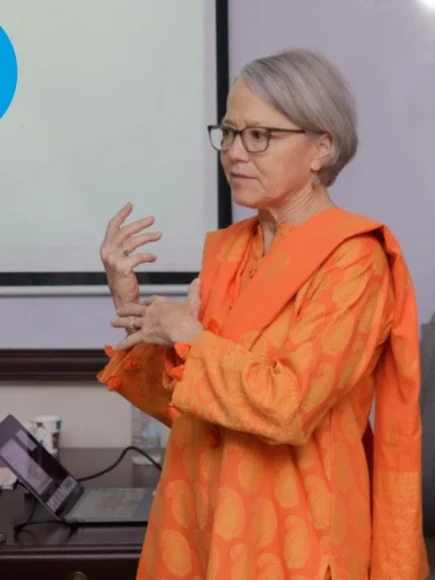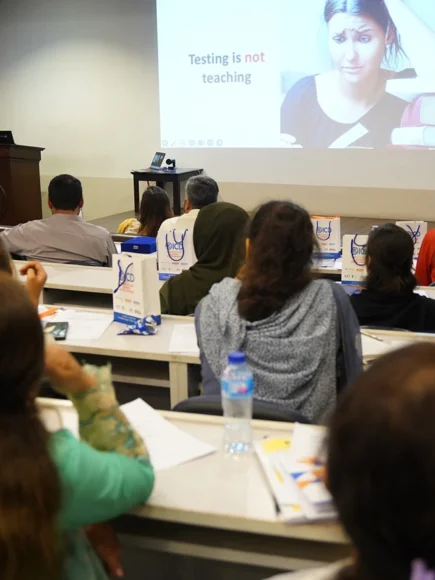CELTA

Celta
-
Description
-
Admission Process
-
Curriculum
-
Accommodation
-
Use of AI in assessed work
Description:
CELTA (Certificate in English Language Teaching to Speakers of Other Languages) by Cambridge Assessment English is the most widely accepted and internationally recognized training program that has been running for over four decades. CELTA is the most sought after certificate for teaching jobs and opens the doors of opportunities all over the world. Every year over 10,000 people take a CELTA course.
Who is this course for?
CELTA is an ideal course for people applying for a teaching job abroad. Many highly paid teacher trainer and academic coordinator jobs in Pakistan demand a CELTA. Recent graduates, people changing career, and teachers who want a formal English language teaching qualification and want to pursue a higher level qualification like Delta may apply.
Eligibility Criteria:
Candidates should be:
• At least 20 years of age
• C1 level or above in English i.e. proficient users of English
• Having a teaching aptitude
• Dedicated, passionate and motivated individuals
All candidates have to pass ICD’s rigorous admission process which will include Language Proficiency test and a mandatory interview (subject to passing the pre-interview task).
Admission Process:
Step 1: Submit your application by filling out the ICD application form. The application form includes a personal statement of 150-250 words. Please note that any plagiarism detected in the personal statement may result in the rejection of the application.
Step 2: Pay the Admission Processing Fee (Non-refundable)
Step 3: Short-listed applicants appear in the Admission Test (Online English Test assessing all 4 skills LRWS at C1 level). This can be online. The following students will be exempted from the admission test, going directly to Stage 4.
CELTA applicant must have CEFR Level C1 on English proficiency in 4 skills, See some popular exams one of which you can submit during admission process Duolingo score 130 . IELTS 7 , TOEFL iBT 98-103 score See https://englishtest.duolingo.com/scores , CAE C1 level 193-199 score with Grade B, ( See https://www.cambridgeenglish.org/exams-and-tests/advanced/results/ ) . PTE 76-84 ( See https://www.pearsonpte.com/pte-academic/scoring/understand-your-score ) Linguaskill Cambridge score 180+ ( See https://www.cambridgeenglish.org/in/exams-and-tests/linguaskill/results/ ) - or any other center based or supervised test with C1 result.
Step 4: Submit the pre-interview task by the allocated deadline. (Provided to the applicants who successfully clear Step 3 via email).
Step 5: Interview Process
Shortlisted candidates will be invited to a 75-minute online interview via Zoom. During the interview, we will assess your language awareness, teaching ideas, speaking, and reading skills. Additionally, you will be required to complete a 30-minute writing task given by the interviewer.
Step 6: Submit a deposit of £500 (accepted in pounds only) within 2 weeks of receiving an offer letter. (This may change for those applying closer to the course date).
Step 7: Submit the remaining £1000 (accepted in pounds only) at least 4 weeks before the course start date.
Please note: There are limited seats on the course. Admission interviews will be conducted on a first-come basis and only the initial candidates qualifying for the course will be registered. The application process may take up to 4 weeks, so please be patient!
Each step has different passing criteria. The admission committee holds the right to reject an application at any stage. The committee is not liable to inform the applicant of the reasons for rejection. The decision of the committee is final. ICD offers a pre-CELTA course to help applicants prepare for the course. Contact ICD for further details of the course.
What You`ll Learn on This Course
During the course, you will cover the following areas. Each input session is designed in such a way that you will receive both the required theory and practical ideas to take with you into the classroom.
| Productive skills | Speaking and writing skills |
|---|---|
| Receptive skills | Reading and listening skills |
| Phonology | The phonemic chart, sentence stress, word stress, drilling techniques, features of connected speech |
| Vocabulary / lexis | What it means to “know” a word, synonyms, antonyms, homophones, homonyms, lexical sets, etc. |
| Language analysis/grammar | How to dissect language for in-class presentation |
| Lesson planning | Planning a lesson, planning a series of lessons |
| Teaching basic literacy | Basic needs of the literacy learner |
| Materials design / evaluation | Using and evaluating authentic and published materials |
| Teaching methodology | PPP (Presentation, Practice, Production), TTT (Test, Teach, Test), presenting language through a text (Guided Discovery) |
| Features of teaching ESOL | Differentiation, teacher roles and responsibilities, testing & exams |
- Practical English Language Teaching Knowledge.
- Real-time Classroom experience and hands-on teaching experience.
- Ability to take on teaching challenges confidently.
- Skills required for teaching jobs anywhere in the world.
- Tools to continue developing your skills as an EFL/ESL teacher.
- Recommended resource Material:
- You are recommended to read the following reference books for the course:
Get a head start on your course with Cambridge free online preparation modules:
These modules will introduce you to the CELTA course and the key theories and concepts it covers. They can be completed before you start your course, to build your knowledge and confidence and give you a head start.
The modules can be completed at your own pace and in any order.
Teaching Methodology:
1- Learning Teaching by Jim Scrivener- Macmillan.
2- How to Teach English by Jeremy Harmer- Longman ELT.
Speaking Skills
3- Keep Talking by Friederike Klippel and Michael Swan- Cambridge University Press.
Grammar Reference
4- Practical English Usage by Michael Swan- Oxford University Press.
5- Grammar for English Language Teachers by Martin Parrott- Cambridge University Press.
Writing Skills
6- Writing Games by J. Hadfield-Pearson Education Ltd.
Reading Skills
7- Reading Games by J. Hadfield- Pearson ELT.
Pronunciation
8- English Pronunciation In Use by Jonathan Marks– Cambridge University Press.
Vocabulary
9- English Vocabulary In Use (Elem – Advanced) by Michael McCarthy – Cambridge University Press).
Classroom Activities
10- Reward Teacher’s Resource Pack by Susan Kay- Longman
Awarding Body
After successful completion of the course, you will get a certificate from Cambridge Assessment English at the levels of Pass A, Pass B or Pass.
About Cambridge
Cambridge Assessment English is part of the University of Cambridge (UK). It is ranked amongst the top 10 universities of the world as per QS World Ranking – followed by HEC Pakistan and the International education community.
Discover accommodation details near the ICD Lahore center by clicking on this link. https://www.icd.org.pk/accommodation
Cambridge English Teaching Qualifications – advice on the use of generative AI in assessed work
Guidance for candidates of CELTA and DELTA Modules Two and Three
The following statement concerning generative artificial intelligence (AI) use for assessed work on CELTA and DELTA is subject to constant review and may be amended, re-written or revoked at any point in the future as the tools evolve and as the academic community arrive at a consensus for use.
Acceptable Use
In their assessed work on CELTA and DELTA Modules Two and Three, candidates may choose to use generative AI tools for the following purposes:
- to generate ideas for teaching and learning materials
- to carry out initial research into a topic in preparation for an assignment
- to generate a bibliography for further research.
Referencing AI
Use All uses of AI must be referenced according to current accepted academic conventions. Any use of AI which is not attributed or referenced, will be treated as an attempt at malpractice (see ‘Malpractice’ and ‘Sources’ below). For all referencing, including references to use of generative AI, candidates should choose one recognized Referencing and Citation style and use it consistently throughout their assignment. The APA style is recommended for CELTA and DELTA, but other recognized styles are also accepted (see the DELTA Handbook). If APA is used, the following conventions for citing AI tools should be followed (candidates choosing other citation styles should check the conventions within their style). When using generative AI tools, a candidate should in all instances include (1) in-text citations and (2) a reference list.
For in-text citations, a candidate should:
- state the prompt or series of prompts used
- ensure the section of the text that was aided by AI is clearly identifiable to the reader with the use of quotes
- include the name of the generative AI program used and the date of use in brackets.
Example of in-text citation: When given the prompt “explain 'used to' to a learner of English” the ChatGPT-generated text indicated that "the phrase 'used to' is used to talk about past habits, actions, or situations that were true or habitual in the past but are no longer true in the present” (OpenAI, 2024).
- In a reference list, a candidate should include the:
- Author
- Date
- Title
- Source
Example of reference list: OpenAI. (2024). ChatGPT (Mar 27 version) [Large language model]. htps://chat.openai.com/c/25f36bd6-cfa6-45f2-8385-a33e12e91a60
Here is the above example reference broken down into its component:
- author – the author of the model, in this case “OpenAI”
- date – the year of the version used, in this case “2024” in brackets
- Title – the name of the model, “ChatGPT”, serves as the title and is italicized; the descriptor “Large language model” is in square brackets
- source – the URL that links as directly as possible to the source
Malpractice
If a candidate is found to have failed to acknowledge their use of AI, this will be treated as an attempt at malpractice and could lead to disqualification. Please refer to Cambridge English’s malpractice procedure for teaching qualifications.



